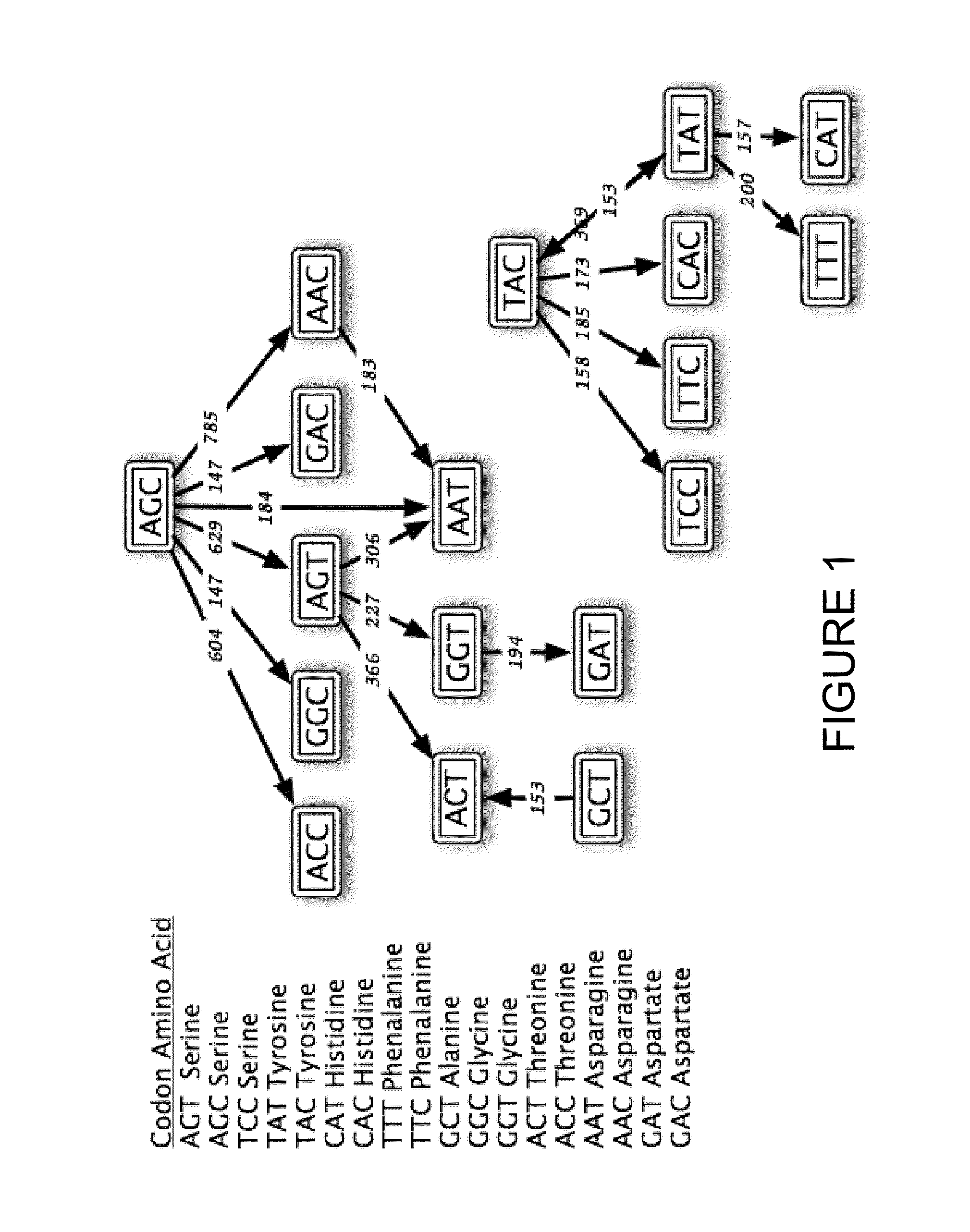Methods of generating libraries and uses thereof
a technology of polynucleotide seed library and library, applied in the field of library generation, can solve the problems of long development time, system often works against the more rapid development of improved therapeutics, and continues to evolve the antibody-as-drug modality, and achieves the effect of reducing susceptibility to somatic hypermutation and enhancing function
- Summary
- Abstract
- Description
- Claims
- Application Information
AI Technical Summary
Benefits of technology
Problems solved by technology
Method used
Image
Examples
example 1
Creation of Synthetic Polynucleotides Encoding Blasticidin
[0664]By decreasing the likelihood of somatic hypermutation in a vector element, such as a selectable marker, an enzyme involved in SHM, or a reporter gene, the vector and system for exerting and tracking SHM becomes more stable, thereby enabling somatic hypermutation to be more effectively targeted to a polynucleotide or library of polynucleotides of interest.
A. Polynucleotide Design
[0665]In general, sequences are engineered for SHM using the teaching described herein, and as elaborated in sections III and IV of U.S. application No. 60 / 902,414, entitled “Systems for Somatic Hypermutation.” In the following examples, sequence optimization is based on the hot spot and cold spot definitions listed herein in Table 6), and using the computer program SHMredesign:
[0666]Using this program, every position within the sequence is annotated with either a ‘+’, ‘−’, or ‘.’ symbol to designate whether it is desired to obtain a hotter, a co...
example 2
Creation of Synthetic Polynucleotides Encoding Enzymes Involved in SHM
Cytidine Deaminase (AID)
[0689]Analysis of sequence variations in cytidine deaminase (AID) between mammalian species (rat, chimpanzee, mouse, human, dog, cow, rabbit, chicken, frog, zebra fish, fugu and tetraodon (puffer fish)) as compared to humans demonstrates that organisms as distantly related as human and frog display a surprisingly high (70%) sequence identity, and >80% sequence similarity. In addition, it has been shown that AID from other organisms can be substituted for human AID in somatic hypermutation (SHM), and that all mammalian species of AID are functionally equivalent.
[0690]Shown in FIG. 11 is a comparison of human AID with other terrestrial AIDs in order to identify a potential beginning construct for SHM in vivo. The figure provides a sequence alignment of AID from human (H_sap / 1-198), mouse (M_musc / 1-198), canine (C_fam / 1-198), rat (R_norv / 1-199), and chimpanzee (P_trog / 1-199). FIG. 15 illustrat...
example 3
Vectors for Somatic Hypermutation
[0710]Vectors are constructed from sub-fragments that are each synthesized by DNA2.0 (Menlo Park, Calif.). Vectors are able to simultaneously express multiple open reading frames and are capable of stable, episomal replication in mammalian cells that are naturally permissive or rendered to be permissive (i.e., via co-expression of human EBP2 (Habel et al., 2004; Kapoor et al., 2001) for replication of Epstein Barr Virus (EBV) origin of replication (oriP) containing vectors.
[0711]Plasmids are rendered highly modular through the strategic placement of one or more restriction endonuclease recognition sequences (restriction sites) between discreet fragments throughout the vector.
[0712]A. Vectors Formats.
[0713]In the first format (FIG. 17A); vectors contain an internal ribosome entry site (IRES) from the encephalomyocarditis virus (EMCV). Elements contained within the vectors are operably linked together as shown in FIG. 17A and, in some cases, include th...
PUM
| Property | Measurement | Unit |
|---|---|---|
| nucleic acid | aaaaa | aaaaa |
| density | aaaaa | aaaaa |
Abstract
Description
Claims
Application Information
 Login to View More
Login to View More - R&D
- Intellectual Property
- Life Sciences
- Materials
- Tech Scout
- Unparalleled Data Quality
- Higher Quality Content
- 60% Fewer Hallucinations
Browse by: Latest US Patents, China's latest patents, Technical Efficacy Thesaurus, Application Domain, Technology Topic, Popular Technical Reports.
© 2025 PatSnap. All rights reserved.Legal|Privacy policy|Modern Slavery Act Transparency Statement|Sitemap|About US| Contact US: help@patsnap.com



